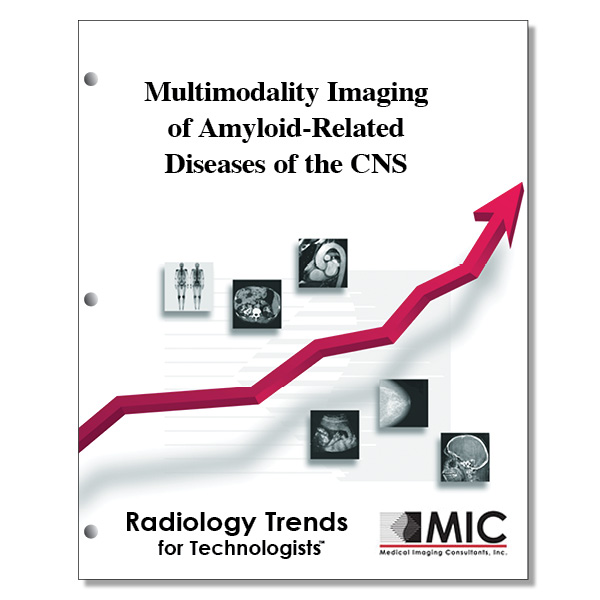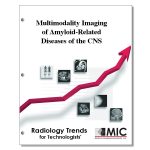

Multimodality Imaging of Amyloid-Related Diseases of the CNS
A review of amyloid-related diseases, pathophysiology, and imaging patterns.
Course ID: Q00490 Category: Radiology Trends for Technologists Modalities: CT, MRI, Nuclear Medicine, PET2.25 |
Satisfaction Guarantee |
$24.00
- Targeted CE
- Outline
- Objectives
Targeted CE per ARRT’s Discipline, Category, and Subcategory classification for enrollments starting after February 14, 2023:
[Note: Discipline-specific Targeted CE credits may be less than the total Category A credits approved for this course.]
Computed Tomography: 0.75
Procedures: 0.75
Head, Spine, and Musculoskeletal: 0.75
Magnetic Resonance Imaging: 0.75
Procedures: 0.75
Neurological: 0.75
Nuclear Medicine Technology: 0.75
Procedures: 0.75
Other Imaging Procedures: 0.75
Registered Radiologist Assistant: 2.25
Procedures: 2.25
Neurological, Vascular, and Lymphatic Sections: 2.25
Outline
- Introduction
- Characteristics of A≤
- Characteristics of AD
- Clinical Features
- Pathophysiology
- Imaging Features
- Findings at Structural Imaging
- Findings at FDG PET
- Findings at Amyloid PET
- Findings at Tau PET
- Characteristics of CAA
- Clinical Features
- Pathophysiology
- Imaging Features
- Characteristics of Inflammatory CAA
- Clinical Features
- Pathophysiology
- Imaging Features
- Characteristics of Cerebral Amyloidoma
- Clinical Features
- Pathophysiology
- Imaging Features
- Conclusion
Objectives
Upon completion of this course, students will:
- list the common isoforms of Ab peptide
- describe the percentage of patients with dementia that have AD or AD mixed with another type of dementia
- identify the major cause of dementia that includes a clinical symptom of visual impairment
- list the criteria associated with a diagnosis of probable AD
- list the classes of medications that have been approved by the U.S. Food and Drug Administration to improve the cognitive symptoms of AD temporarily
- identify the Ab-related disease that demonstrates a solidly enhancing mass at CT or MR imaging
- describe the genetic mutation that increases an individual’s risk for AD up to 15-fold
- identify the brain location where neurofibrillary tangles typically form first
- list the CSF biomarkers that have been incorporated into the diagnostic guidelines for AD
- identify the brain region that typically demonstrates gross neuropathologic changes in the setting of AD
- describe the imaging modalities that may be particularly helpful when evaluating patients in whom the cause of dementia is uncertain
- identify the lobes of the brain where cortical volume loss at structural imaging is more prominent in patients with AD
- list the brain regions that demonstrate hypometabolism at FDG PET in the early stages of AD
- identify the brain region in which FDG PET is not well suited to showing physiologic changes in patients with AD
- describe the usefulness of FDG PET in distinguishing AD from other causes of dementia
- list the AD indications for which FDG PET is reimbursed by Medicare and Medicaid
- describe the chemical structure of the PET imaging agent Pittsburgh compound B (PiB)
- identify the amyloid PET imaging agents that are approved by the U.S. FDA for clinical use in imaging patients with AD
- list the patient conditions that can demonstrate Ab deposits in the brain
- describe the appropriate use criteria for amyloid PET imaging
- identify the brain regions that demonstrate increased uptake at tau PET imaging in a patient with AD
- list the conditions that can demonstrate brain uptake of tau PET imaging agents
- describe the comorbidities that are linked to increased prevalence of CAA
- list the histologic features associated with a severe grade of CAA
- identify the brain regions that demonstrate hemorrhage in patients with CAA
- identify the lobes of the brain most frequently affected by cortical hemorrhages in patients with CAA
- describe the imaging modality that is indicated in CAA patients with acute neurologic symptoms for exclusion of acute ischemic stroke
- compare susceptibility-weighted MR imaging and gradient-echo MR sequences in the detection of cortical and subcortical microhemorrhages in CAA patients
- identify the brain region that demonstrates a typical pattern of leukoencephalopathy at CT or MR imaging in patients with sporadic CAA
- describe the Ab-related disease that demonstrates perivascular lymphocytic infiltrate with edematous gyri at autopsy
- describe the Ab-related disease that demonstrates leptomeningeal enhancement in edematous areas at imaging
- identify the Ab-related disease with an imaging appearance that closely resembles that of CAA-related inflammation
- describe the rarest form of intracerebral Ab deposition
- list the CNS conditions that may mimic amyloidoma at imaging
- describe the MR imaging sequence that best demonstrates the perilesional edema associated with cerebral amyloidoma
